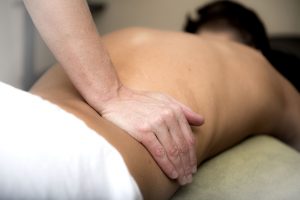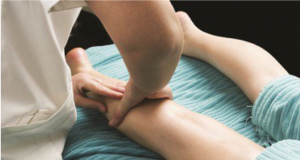Just The Facts!
“How long will it take to get better?”
I think it is every professionals dream to be able to answer this question with complete certainty. We would like nothing more than to be able to give you a definitive time frame as to ‘how long’ it takes to recover from an injury. The honest answer will always be “It depends”.
I have been treating soft tissue injuries since 1995 and regardless if the patient was an Olympic volleyball player, a professional basketball player or a recreational runner, the healing process is always the same. In my previous life as an athletic trainer, I had access and license to use other means such as ultra sound and electrical stimulation to aid in my treatment strategy, but as a massage therapist, we are more limited in our scope of practice. That isn’t necessarily a bad thing considering that the use of methods such as ultrasound is unproven to be effective in the treatment of musculoskeletal conditions.
“As yet, there seems to be little evidence to support the use of ultrasound therapy in the treatment of musculoskeletal disorders. The large majority of 13 randomized placebo-controlled trials with adequate methods did not support the existence of clinically important or statistically significant differences in favor of ultrasound therapy.” Windt et al, “Ultrasound therapy for musculoskeletal disorders: a systematic review,” Pain, 1999
When it comes down to it, the number one factor in successfully treating a musculoskeletal injury is rest from the aggravating activity. That is likely the last thing any of our runners want to hear when the have a big race coming up. Our role as professionals is not to tell patients what they want to hear, but rather what they need to know. With the right information, the patient can make an informed decision about how they should handle their injury.
The most conventional method for self-treating an injury are NSAID’s (non-steroidal anti-inflammatory drugs) ice and stretching. So why doesn’t anyone get better when they take this path that is recommended by a majority of doctors and professionals? Well, the most significant factor is that there is not any inflammation, at least not in the classical sense. Yes, this is VERY true.
What’s in a name?
Common conditions you hear about such as achilles tendonitis, plantar fasciitis or medial epicodylitis are thought to be inflammatory. The suffix ‘itis’ which means ‘inflammation of” is in their names, so why wouldn’t anyone think that it is an inflamed condition? Well, because medical research from 15 YEARS AGO proved that these conditions are NOT an inflammatory condition of the tissues, and have been determined to be something else.
“Numerous investigators worldwide have shown that the pathology underlying these conditions is tendinosis or collagen degeneration.”
Khan et al. Overuse tendinosis, not tendinitis, part 1: a new paradigm for a difficult clinical problem (part 1). Phys Sportsmed. 2000. PubMed #20086639.
Where’s the Fire?
The word inflammation denotes thoughts of redness, swelling and heat. However, if there is no inflammation, we must stop trying to hose down a fire that doesn’t exist. Given the assumption of inflammation, we are programmed to squash the ‘heat’ with ibuprofen and ‘cool’ the pain with ice. If injuries escalate, doctors may get really serious and inject something like a corticosteroid (don’t do this either). This is the conventional wisdom yet people aren’t getting better? The issue is that the condition we are dealing with is an “osis” or a “degeneration of” the tissue. Pain science writer Paul Ingraham says it best.
“It’s like premature arthritis in any overloaded tissue, which can’t repair itself fast enough to keep pace with the stresses placed upon it. The fundamental problem is more likely to be failed healing: that the cells can’t keep up with repairing the damage to the connective tissue structures they are tasked with maintaining. The cells aren’t broken — they’re just like Lucy trying to keep up with the conveyor belt of chocolates.”
You may rest for a day, a week, even two, yet no change. I tell patients with these types of RSI’s (repetitive strain injuries) to consider this damage to the tissue like that of a broken bone. Who of us thinks that a bone will mend in just two weeks? None of us. If we start to consider that the damaged tissues need to mend like a bone and not like paper cut, we can start to better understand the recovery process. Certainly bone mending takes longer than tissue healing, but without proper attention, the injury can linger much longer than it would take a broken bone to fully heal.
One of the first things I hear patients doing is popping NSAID’s. I know of runners who swear that if they don’t take them, they won’t recover as well. Well, the science has proven that there is zero evidence that this works either. Perhaps the old placebo effect has its place here, but there is no science to validate this action. NSAID’s can actually retard soft tissue healing, which is not what you are shooting for. At least they don’t damage connective tissues like corticosteroid injections have been shown to do.
“It is clear that corticosteroid injection into tendon tissue leads to cell death and tendon atrophy. As tendinosis is not an inflammatory condition, the rationale for using corticosteroids needs reassessment, as corticosteroids inhibit collagen synthesis and decrease load to failure.”
Khan et al. Histopathology of common tendinopathies. Update and implications for clinical management. Sports Medicine. 1999. PubMed #10418074.
NSAID’s can also be pretty hard on your gut, but given the alternative of using something like Tylenol (acetaminophen), which is very tough on the liver, the choice is yours. This reminds me of a hilarious bit by popular stand up comedian and Lexington, MA native, Louis CK.
Here’s the rub!
If the condition you are suffering from was an inflammation, it would subside within a couple of weeks of proper rest, NSAID’s and icing, but alas, we know this is not the case. It is because the underlying condition is tissue degeneration. The healing process will take more like 6-12 weeks provided proper rest, 'rehab' and several other factors are in play.
From the perspective of a massage therapist, there are plenty of thing we can do to assist in the process and perhaps even expedite it. The first is that in most RSI’s, there are commonly trigger points that must be addressed. Failure to address these will perpetuate pain-producing metabolites that are hampering the healing process. Another tool we have at our disposal is kinesiology tape. KTape has been shown to be very effective in the treatment of musculoskeletal disorders primarily due to the fact that the tape can stay on for multiple days while providing therapeutic benefit and assistance with the soft tissue work being performed. I recent study in the British Journal of Sports Medicine concluded that research does support the use of kinesiology tape to reduce musculoskeletal pain.
Lim and Tay concluded, “Kinesiology tape is superior to minimal interventions for pain relief.” Furthermore, “When used in combination with conventional therapy, kinesiology tape may be effective at reducing pain.”
The bottom line is that RSI’s by definition have crept up over a prolonged period of time. If you want to do your best to avoid the injury, commonsense will tell us to provide as much time for recovery as we do for training. Consider rewarding your body for its performance rather than literally working it down to the bone. When a proper method of recovery is implemented into your workouts, you will effectively reduce the risk of these types of injuries.
So the next time you have an injury that seems to be creeping up on you, be sure to address it first with offering the injured area some proper rest. There are many self-massage techniques that you can apply while giving the area some rest. If that doesn’t seem to provide the appropriate relief, the next step would be to consult someone who has experience in helping patients to effectively treat these injuries. Next month, I will share with you some of these techniques, such as reducing trigger points.
Ready to #feelbetter?
You're just a click away from a wicked good massage!
-

60 Minute Massage Gift Card
$170.00 Add to cart -

90 Minute Massage Gift Card
$255.00 Add to cart -

Mini Aer Small Room Air Purifier
$149.00 Add to cart -
Sale!

Thera-Pearl Sports Pack/Hot Cold
Original price was: $14.99.$12.99Current price is: $12.99. Add to cart -

3 Somadome Sessions Gift Card
$135.00 Add to cart -

20 Minute Somadome Gift Card
$45.00 Add to cart -
Sale!

TheraBand® Stretch Strap
Original price was: $19.99.$14.99Current price is: $14.99. Add to cart -

TheraBand CLX Connective Loop
$14.99 Select options
Energy Boosters
Energy Boosters Ways to Get You Through the Day No amount of coaxing, pleading, or pedal pumping could get the engine in the rental car to turn over. It was going nowhere. The travelers had filled the car with unleaded fuel, but it had a diesel engine. It had been able to run a little…
Read MoreWhat is Qi?
What is Qi? A fundamental concept of traditional Chinese medicine (TCM) dating back over 3,000 years, qi (pronounced “chee”) is the Chinese word for energy, which also carries with it connotations of “air,” “breath,” and “life force.” In TCM, it is understood that everything from humans and animals to rocks and trees is filled with…
Read MoreWhy Buy Organic?
Why Buy Organic? Is the Higher Price Worth It? While shopping in your grocery store’s produce section, you may notice the organically grown apples are pocked and not as big and perfectly round as the conventional produce, but they are more expensive. What’s the difference, and which do you choose? Your decision may significantly impact…
Read MoreAre You Making the Most of Your Massage?
Are You Making the Most of Your Massage? How to Prolong the Benefits of Bodywork A massage works in wonderful ways, easing stress and pain, calming the nervous system, increasing circulation, loosening tight muscles, stimulating internal organs, and enhancing skin. The multiplicity of physiological responses sends a simple, clear message to the mind: Massage feels…
Read MoreThe Case for Chocolate
The Case for Chocolate New Studies Show Health Benefits It’s not like we need a specific reason to eat chocolate, but it doesn’t hurt that studies are finding increasing health benefits associated with the popular indulgence. While chocolate is high in sugar and saturated fat, it does contain chemical compounds with proven benefits, so enjoy–in…
Read MoreThe Wonders of Water
The Wonders of Water For Skin Health and More Shelley Burns, N.D. Creams, nutritional supplements, treatments, lotions, and potions. We are always looking for the next miracle product to keep skin looking healthy and young. However, there is one essential, inexpensive, and often overlooked nutrient right at your fingertips:water. Just as a car cannot function…
Read MoreInvest In Your Health
Invest in Your Health Massage Offers Excellent Return onInvestment “Invest for the long term” is great financial advice, but it’s also great healthcare advice. Never is investing for the long term more important than when you are making day-to-day decisions about your health. There are short-term gains from taking care of your health, to be…
Read MoreLife Hack: Iced Cubes
Life Hack: Coffee Cubes (Redux) As usual in New England, we have gone from Winter to Summer, with Spring being an absentee season (again). Since it feels like Summer is already here, I thought it best to give you a Life Hack that is an oldy, but a goody! Iced Coffee…..CUBES! #mindblown Yes. I have offered this…
Read MoreMake a Great Save to Avoid Back Pain
Make a Great Save to Avoid Back Pain 7- Stretches in 7-Minutes I was speaking the other day with one of our therapists and we were discussing our role in helping our patients. I was explaining that a comment I often tell new patients is; “These are hands, not magic wands”. Patients often seek out…
Read MoreTime for Sleep
Time for Sleep As a nation, we may be divided, but there is one common bond that unites us all around the world; sleep. We all need sleep in order to be capable of performing every day tasks. Sleep is an imperative part of the human experience. Without a good night’s sleep, our bodies will slowly…
Read More









